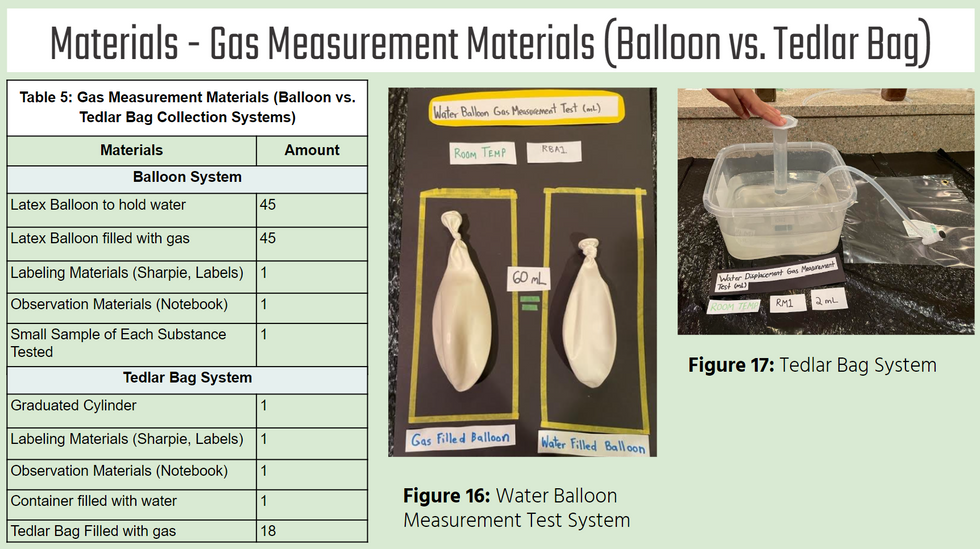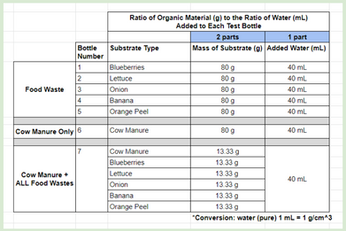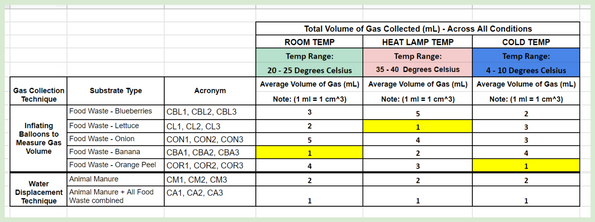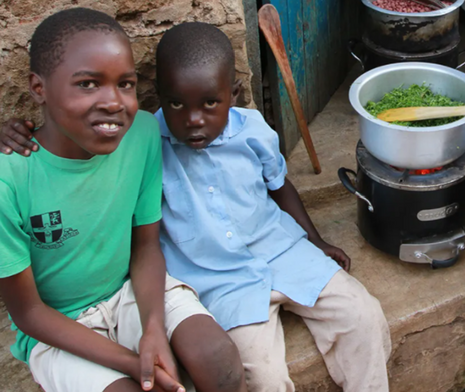

Table of Contents:
Purpose:
The purpose of this experiment is to test the effectiveness of using food wastes and cow dung in a low cost, low tech biodigester to generate methane gas for cooking in developing countries to reduce their dependence in polluting firewood and expensive fossil fuels.
Questions:
Which substrate will produce the most biogas?
What is the ideal temperature for maximum biogas production?
Why is the temperature an important factor in the production of methane?
Do different substrates produce methane at a different rates?
What is the relationship between the level of methane produced and what happened to the balloon?
Overall Question:
What are the factors affecting the performance of a biogas digester?
The Importance of Biogas - A Global Challenge

More than 20 percent of the world’s population, do not have access to electricity, and 45 percent of the world’s population rely on firewood, crop residues, cattle dung, or coal to meet their cooking needs. With rapid population growth, energy demand is expected to continue to increase by 28 percent by 2040, mostly in Africa, the Middle East, and Asia.
Biomass, which comprises 10–14 percent of the total global energy demand, accounts for over 90 percent of household energy consumption in many developing countries, where most communities are disconnected from the grid.
Dependence on solid fuels and inefficient, polluting cookstoves is one of the world’s major public health challenges, imposing significant economic costs on those that can least afford them, while negatively impacting the environment and climate For households with suitable access to organic feedstock, one promising alternative is the use of biogas as an energy source.
Anaerobic Digestion - Overview:
Why Cow Manure?
An anaerobic digester is like a cow’s stomach on an industrial scale—it’s an oxygen-free environment where biological processes break down organic matter. As cows chew their meal it moves into their stomach, where microbes break down the food. The cow passes the digested food as manure, which is then driven to a digester. Inside the digester, bacteria use biological catalysts, called enzymes to break down the manure insoluble polymers, including cellulose, into smaller, soluble components. These smaller components, such as glucose, get broken down even further, and the gases CO2 and CH4 are produced.

How is Biogas Produced?

Biogas energy is the energy that is made from the fermentation of organic matter and from anaerobic digestion.
This type of energy is made from sewage sludge, manure, solid waste, biodegradable waste, and other biodegradable feedstock.
How is Methane (CH₄) Produced? The Four Steps of Anaerobic Digestion

The four key stages of anaerobic digestion involve hydrolysis, acidogenesis, acetogenesis and methanogenesis.
The overall process can be described by the chemical reaction, where organic material such as glucose is biochemically digested into carbon dioxide (CO2) and methane (CH4) by the anaerobic microorganisms.
Foundation for Experimental Design:

What is Anaerobic Biogas Powder?

Bacta Cult Anaerobic Powder was sourced from a biogas company (Biotech Amalgam) in India. Bacta Cult is an anaerobic powder and is used in the startup of industrial anaerobic digester systems. It improves biogas generation capacity.
In a real biodigester it improves the hydrolysis and methanogenesis stages of the anaerobic process. It is also used on a daily basis to assure the quick recovery if the pH is not ideal for the bacteria to make biogas.
In my project it is like a seed starter. I tested cow dung / manure with the biogas powder to see - Does the powder increase the quantity of gas produced?
The package directions indicate mix 1 Kg of Bacta Cult in 20 Liters feed water.
Hypothesis and Variables:
Hypothesis:
If I test different types of substrates used in biogas production (animal manure, food waste) then the methane yield from food waste will be greater than animal manure because food waste has a higher energy-generating potential.
Independent Variables:
Digestive Substrate (Animal Manure, Food Waste) (grams)
Environmental Temperature (℃)
Dependent Variables:
pH of the biomass (scale 0 - 14)
Environmental Temperature (℃)
Volume of Biogas Produced (mL)
Constants:
Source and method of manure and food waste processing (farm), Weight of Biomass (grams), Biomass to water ratio (2:1), Retention time for biogas collection (days), Lab Testing Materials, Safety Equipment, Data Recording Materials / Utensils.
Materials:
Acronym Table + Sampling Plan:
Procedure:
Substrate Bottle Preparation:
Wash and dry the plastic bottles.
Recycle the caps of the bottles that will have a balloon on top
Label each bottle according to the acronym and sampling chart


Manure Bottle Preparation:
Put on safety equipment
Put one of the small paper cups on the balance scale and zero out the scale
Using the scale and small paper cup, measure out 80 g of fresh manure
Using the graduated cylinder, measure 40 mL of water
Mix the water and manure mixture together with a stir stick
Use a funnel to put the mixture in its labeled plastic bottle
Repeat steps 1 – 6 for all bottles labeled manure (total of 9 bottles)
Cut the thin tubing to about 1 foot and repeat 18 times
Hot glue the thin tubing into the cap and make sure there are no leaks. Repeat for each tube.
Put the cap and tube assembly on the bottle
Dispose of gloves and wash hands with soap and warm water

Preparing Food Waste Bottles:
Puree each of the Food Wastes (blueberries, lettuce, onion, banana, orange peel) using the Magic Bullet and place each in a small paper cup
Put one of the small paper cups on the balance scale and zero out the scale
Using the scale and small paper cup, measure out 80 g of each puree
Using the graduated cylinder, measure 40 mL of water
Mix/puree the water and puree mixture together
Use a funnel to put each puree in its labeled plastic bottle

Preparing Manure + Food Waste Bottles:
Put on safety equipment
Put one of the small paper cups on the balance scale and zero out the scale
Using the scale and small paper cup, measure out 13.3 g of fresh manure
Puree each of the Food Wastes (blueberries, lettuce, onion, banana, orange peel) using the Magic Bullet and place each in a small paper cup
Using the scale and small paper cup, measure out 13.3 g of each puree
Using the graduated cylinder, measure 40 mL of water
Mix the water and manure mixture together with a stir stick
Combine the Manure and Food Waste ALL into one bottle
Cut the thin tubing to about 1 foot and repeat 18 times
Hot glue the thin tubing into the cap and make sure there are no leaks. Repeat for each tube.
Put the cap and tube assembly on the bottle
ALL the manure filled bottles should be connected to a Tedlar Bag
ALL the Food Waste bottles should have a balloon on top
Dispose of gloves and wash hands with soap and warm water

Preparing Manure + Anaerobic Biogas Powder Bottles:
Put on safety equipment
Put one of the small paper cups on the balance scale and zero out the scale
Using the scale and small paper cup, measure out 80 g of fresh manure
Using the graduated cylinder, measure 40 mL of water
Mix the water and manure mixture together with a stir stick
Measure and mix in your Anaerobic Biogas Powder according to the instructions
Use a funnel to put the mixture in its labeled plastic bottle
Repeat steps 1 – 7 for the other Biogas Powder bottle
Cut the thin tubing to about 1 foot
Hot glue the thin tubing into the cap and make sure there are no leaks.
Put the cap and tube assembly on the bottle
Cover the other bottle with a balloon
Dispose of gloves and wash hands with soap and warm water

Testing for pH Collection:
Get a small sample of each Food Waste substrate
Test (according to package instruction of pH test kit)
Use the distilled water to clean strips
Record pH for Trial 1, Trial 2, and Trial 3
Get Manure sample
Test (according to package instruction of pH test kit)
Use the distilled water to clean strips
Record pH for Trial 1, Trial 2, and Trial 3
Get Food Waste and Manure Bottle
Test (according to package instruction of pH test kit)
Use the distilled water to clean strips
Record pH for Trial 1, Trial 2, and Trial 3

Volume Measurement:
Remove the balloon off of the clear bottle
Quickly close the balloon so that no gas can escape
Lay the balloon on the left side of your recording template (see figure) on this slide
Take another empty balloon and fill it with water until it resembles the size of the balloon that is filled with gas
Empty out the balloon filled with water into a graduated cylinder. Record the volume in mL. This volume of water will be the approximate volume of gas in the gas filled balloon.
Repeat for all the bottles that have gas balloons at all the three different temperature conditions.

Volume Measurement - DISPLACEMENT method:
* This method displaces water to measure gas
Fill the basin with 25 mL of water
Fill the graduated cylinder ALL THE WAY to the top
Use your thumb to cap the top of the graduated cylinder, and invert it into the basin
Connect one end of the tubing to the gas collection bag and place the other end underneath the graduated cylinder (still in the basin)
Let the gas flow through the tube into the graduated cylinder. The gas will collect at the top of the graduated cylinder and force the water out
Observe how many mL of water was pushed out. This is the volume measurement of the gas.
Record Results
Data Collection:

Data Analysis:

Cow Manure and Food Waste Puree:
I sourced the cow manure from a local farm in Herndon, VA (Franklin Farm). It was important the cow manure was fresh to ensure that the microorganisms are viable. The ratio of manure to water was kept constant throughout the experiment (2:1). The ratio of Food Waste (Fruits and Vegetables) to water was also 2:1 throughout the experiment. The manure was mixed with water to create a slurry. The fruits and vegetables were chopped small and pureed with water.
One sample at all three temperature conditions had cow manure, all the food wastes and water together in a single bottle. In agriculture, co-digestion refers to the simultaneous anaerobic digestion of multiple organic wastes in one digester. Many farmers use agricultural wastes with manure to boost methane production - instead of using just manure alone.
In an Industrial scale biogas system Retention Time is the amount of time the biodigester is operating before the biogas is extracted from the system.
Experiment Duration:
The length of my experiment (data recording / observation phase) was 11 days.
A brief retention time does not allow the bacteria enough time to digest the manure, and a long retention time does not furnish enough fresh slurry to promote bacterial growth and a high gas production rate. I noticed that by day 11 the bottles that did collect gas in a balloon - the balloon had deflated. This experiment did not introduce new puree or manure to the bottles on a daily basis. The volume in the digester remained constant.

Mold Development:
Mold developed in the Food Waste (fruits and vegetable) substrate bottles starting around day 3 and 4. By day 5 - 6 all the Food Waste Bottles had mold that developed on the surface of the puree. All the bottles were left stationary. Shaking the bottles would be adding oxygen, which would inhibit the methanogens.
On day 6 I gently tilted all the bottles approximately 45 degrees. This was to release any gas that could be trapped underneath the mold. In an industrial biodigester a mechanical device mixes the slurry within the digester by maintaining a uniform temperature and bacteria and volatile solids distribution throughout the slurry. It prevents a crust from forming on top of the slurry which interferes with the release of biogas. By tilting the bottles I tried to replicate this process.
pH:

The values of pH range from 0 - 14. Acidic foods are classified as in the range of 0.0 - 6.9. The necessary pH for anaerobic digestion ranges between 6.8 to 8.5 and varies depending on which stage of the anaerobic digestion process is occurring. Lower pH (i.e. more acidic) conditions inhibit biogas production because the methane bacteria cannot survive (die off). Most food waste tend to decompose quickly and can decrease the pH of the digester. Cow manure tends towards a neutral pH. Adding Food Waste should alter the overall pH. In my experiment the however, the pH did NOT change and stayed at pH = 6.0
Temperature:
I studied my bottles at three different temperatures. I used an Infrared Thermometer to observe the temperatures in all three locations.
Room Temperature: All bottles were left out at 20 - 23 degrees Celsius. The average temperature was 22.6 degrees Celsius.
Heat Lamp: I used four heat lamps, and insulated the cardboard boxes with aluminum foil to create a warm environment. The temperature ranged from 35 - 40 degrees Celsius. The average temperature was 37.2 degrees Celsius.
Cold Temperature: I used my garage to keep the bottles at the desired temperature during the winter. I monitored the temperature. It ranged from 4 - 10 degrees Celsius. The average temperature was 6.7 degrees Celsius.
Gas Collection:

Two of the Room Temperature, Banana bottles fully inflated on Day 5. They then deflated over the course of the rest of the experiment. Total gas collected for banana at room temperature was 53.67 mL. No other bottles fully inflated throughout the course of this experiment.
The balloons that did not fully inflate still had gas in them. If you felt the balloon you could feel the gas inside even though it was not enough to raise the balloon.
The Maximum amount of gas at Room temperature was from banana at 53.67 mL. The maximum amount of gas from the heat lamp environment was 23.67 mL. The maximum amount of gas produced from the cold temperature was significantly less at only 11.67 mL.

Anaerobic Biogas Powder:

The Anaerobic Biogas Powder Substrate Bottles are made up of Cow Manure, water and Anaerobic Biogas Powder. The ratio of substrate to water was still kept at 2 : 1. 21 g of powder were added to diluted water and cow manure.
The first bottle was connected to a balloon (BC1) and the second bottle (BC2) was connected to a tedlar bag. Both collected similar amounts of gas at 57 mL and 52 mL’s respectively. (Note: 1 mL = 1 cm^3)
Both bottles formed mold after Day 2. The Tedlar Bag bottle formed more mold than the Balloon bottle. Tedlar bag was slower to collect gas compared to the balloon. It is possible that gas could have been trapped in the plastic tubing connecting the bottle to the bag. The tube might have been too long and it might have been more difficult to move the gas through from the bottle to the bag. These are possible sources of experimental error.
Conclusion:
My experiment was successful. My hypothesis was correct. I predicted that If I test different types of substrates used in biogas production (animal manure, food waste) then the methane yield from food waste will be greater than animal manure because food waste has a higher energy-generating potential.
My overall question was, what are the factors affecting the performance of a biogas digester? Biogas production depends on temperature, pH value and the C/N ratio of the biomass. There are other factors that affect biogas production but they are outside the scope of this experiment. I have noted them in the project extension section.
Which substrate will produce the most biogas? Food Waste (fruits and vegetables) produced the most biogas across all three temperature ranges. At room temperature (ideal) banana was ranked number one. Followed by lettuce, blueberry, orange peels and onions. Bananas nutritional composition has a direct impact on the gas produced. It is 89 kCal / 100g, 12 g of sugar, 5.4 g of starch and 23 g of carbohydrates. Onions are only 40 kCal/100g, 4.2 g of sugar, not a significant amount of starch and 23 g of carbohydrates.
Which substrate will produce the most biogas (continued)? When manure alone is combined with food waste (fruits and vegetables) the biogas production is increased.
What is the ideal temperature for maximum biogas production? Why is the temperature an important factor in the production of methane? There are two optimum temperature ranges for methanogens (methane producing bacteria), one at 30–40°C and one at 50–60°C. These are known as the mesophilic and thermophilic ranges respectively. The higher the temperature, the faster is digestion and biogas production. Below 10°C biogas production occurs very slowly if at all, and above 65°C very few strains of bacteria can survive. This supports the results that we obtained. Room temperature across all substrate types did much better than at the cold or heat lamp temperatures.
How does the Carbon and Nitrogen ratio C/N affect biogas production?
One commonly used parameter is the C/N (carbon/ nitrogen) ratio in the fuel stock materials. It has been found that the optimum ratio is between 20 and 30:1 and that too high a ratio restricts the microbial process due to a lack of nitrogen for cell formation while too low a ratio increases the shift towards ammonia toxicity. But there seems to be a wide range of suitable C/N ratios depending on the materials digested. Cow Manure has a C/N ratio of 11:1 - 30:1. This is a wide range because it depends on what diet the cow is fed. The C/N of Food Waste is 14:1 - 16:1 and Fruit is 20:1 - 35:1. This supports my hypothesis. The addition of co digestion materials with higher carbon contents than manure feedstocks can improve the C/N ratio, thereby increasing production. Biogas produced from Manure and Food Waste was greater then just Manure alone. The biogas from fruits and vegetables (higher C/N ratio) did significantly better than the other two combined at all three temperatures.
What is the relationship between the level of methane produced and what happened to the balloon? When the parameters of temperature, pH and C/N ratio are optimized the level of methane gas increases. The balloons inflated more.
Possible Sources of Error:
It is very important to use fresh cow manure in this project to ensure that the microorganisms are viable. My manure based on the farm was approximately 2 days old.
If there is air in the balloon, when you put it on the mouth of the bottle the air will remain trapped in the balloon and this can give you false results.
If enough biomass accumulates at the top of the bottle, it may prevent some biogas from getting into the balloon. carefully tilt the bottle by about 45 degrees (so that it is momentarily horizontal) to dislodge the biomass
If the three bottles for the same condition (for example, all the bottles with cow manure only) do not seem very consistent in how much biogas they are producing, this could be because different amounts of air were trapped in the balloons when they were placed on the bottles
Biogas may escape from the inflated balloons over time. If an inflated balloon deflates a lot, this may be a sign of a leak in the balloon.
If the balloons do not inflate at all then there might not be enough substrate in the bottles or the experiment was ended too early and there was not enough time to develop the methane
Areas of Improvement / Project Extension:
Possible areas where I can improve my experiment is to study the Hydraulic Retention Time (HRT). The longer the hydraulic retention time (HRT) of the feedstock in the digester the greater the biogas yield per unit of feedstock. For a given feedstock loading rate, a longer HRT will correspond with a bigger digester and hence greater capital cost. In practice there is an optimum HRT that is a compromise between gas production and digester volume.
Another very interesting extension to my experiment is the effect of chemicals (antibiotics) on biogas production. Antibiotics are widely used to treat animal diseases. The overuse of antibiotics is inducing issues of pollution, development of resistance by pathogenic bacteria and inhibition of engineered microbial processes such as anaerobic digestion. Since the global consumption of antimicrobials in livestock production is projected to rise to 105 tons by 2030 it is a very important extension of my project to see how it would affect overall biogas production.
The necessary pH for anaerobic digestion ranges somewhere between 6.8 to 8.5 and varies depending on which stage of anaerobic digestion process is occurring. An improvement on studying the effect of pH in the anaerobic digester would be to test the addition of a buffer such as sodium bicarbonate (baking soda) to the bottle to balance the initial high acidity caused by decomposing food waste. This would be a good extension because we know that baking soda is a popular method for treating digestive problems like heartburn, acid indigestion and upset stomachs.

Further Research / Real World Application:
East Africa has the world's highest percentage of people using biomass for cooking. Rural households do not have an alternative solution as less than 4 to 8% have access to electricity. These households have no or unreliable electricity access and use wood or charcoal for cooking.
Companies like SimGas have developed simple, low technology biodigesters to convert manure into biogas - a clean cooking fuel - and produce a nutrient rich slurry that can be used to fertilize fields. Families stop relying on traditional fuels like wood and charcoal. Biogas also eliminates harmful indoor smoke from cooking. It frees up time for women and children who many times are sent out to collect fuel wood, reducing respiratory illnesses.
This experiment is so critical. There are many organizations that use low cost, low technology simple solutions to offer a way for people in the developing world to harness the power of dung for clean cooking.
Dung Power = Gender Equality = Economic Opportunities = Clean Energy for All!
It’s going to take all of us working together to achieve universal access to clean cooking by 2030. This experiment highlights that simple solutions using renewable resources can provide access to millions in the developing world. Lives can be changed one cookstove at a time!


















































Comments